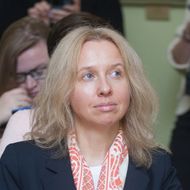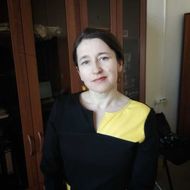- A
- A
- A
- ABC
- ABC
- ABC
- А
- А
- А
- А
- А
- HSE University
- Faculties
- Faculty of Humanities
- School of History
- News
- Research & Expertise
- Studying Cultural History of Ethnic Minorities in the USSR
105066 Moscow, Staraya Basmannaya 21/4, building 3
Phone: +7 (495) 772 95 90 *22858
The HSE School of History was established in 2015 on the basis of the HSE faculty of history. The School's staff brings together leading scientists in various fields of historical knowledge who are widely known and respected in Russia and the international academic community. The School’s instructors are leading historians are authors of numerous books and articles, regular participants in major international scientific forums and research projects, and are also known as popularizers of historical knowledge. The HSE School of History actively cooperates with leading foreign universities and research centers, and organizes international scientific conferences, symposia, and colloquiums.
Strasbourg: Presses universitaires de Strasbourg, 2023.
Misiak M., Butovskaya M., Sorokowski P.
Food Quality and Preference. 2024. Vol. 114.
In bk.: Picturing Russian Empire. Oxford: Oxford University Press, 2024. Ch. 6. P. 66-73.
Kolesnik A., Rusanov A.
Working Papers of Humanities. WP. Издательский дом НИУ ВШЭ, 2021. No. 205.

Studying Cultural History of Ethnic Minorities in the USSR
Isabelle R. Kaplan, a Post-Doctoral Research Fellow at the International Centre for the History and Sociology of World War II and Its Consequences, talks about her research on non-Slavic minorities in the Soviet Union in an interview to the HSE Look, the university bulletin.

Isabelle R. Kaplan
— What is your educational and professional background?
— I came to history later in life – I was not a history major in college. I was a literature major as an undergraduate and I have a Master’s degree in post-Soviet area studies. I taught English and Language Arts in public high schools for a number of years -- all the grades from the 8th grade up. When I moved to Washington, DC where my husband got a job, I adjuncted for a year teaching Russian literature at George Washington University, and following that experience I decided to go back to school for a doctorate. So, my background is in teaching and in cultural studies.
I wanted to do something comparative among different non-Slavic Soviet cultures. I enrolled in a History PhD programme at Georgetown University, intending to study cultural history under Richard Stites, who, sadly, passed away during my second semester. Then I switched to the University of Maryland in order to work with Michael David-Fox. He was then hired by Georgetown, and I switched back to my original school to continue working with him.
— How has your interest in history emerged? And especially in the post-Soviet area?
— I was interested in the cultural history of non-Russian groups—of ethnic minority groups of the Soviet Union during the Soviet period—and the interplay with Russian culture. When I was an undergraduate [Dr. Kaplan received a BA in Comparative Literature from Yale University], work on the non-Russian cultures of the Soviet space was a rarity in literary studies. There was little discussion of, say, Azerbaijan or Kazakhstan, in departments of Slavic languages and literatures. I don’t think these cultures received much attention in Near Eastern studies departments either, at least not from the standpoint of literature and the arts.
In the past, I think those fields were more developed in Russia because of the imperial and Soviet experience, but in the United States, for example, they were more obscure. Nowadays, Slavic departments have come to embrace them, and today there are people doing fantastic work on Georgian, Azerbaijani, Chechen, Tajik, and other literatures, sometimes under the rubric of Turkish or Near Eastern studies, as well. In addition, the work of scholars from the Caucasus and Central Asia is increasingly available in English.
The academic landscape has changed a lot over the last couple of decades.
I chose History because it seemed the most capacious, and because I had encountered specific historians whose approaches appealed to me and whose work served as models.
First, I started learning Turkish, and then Azerbaijani. The languages are very similar—many Azeris can understand Turkish—but as a non-native speaker, I find the differences between them very pronounced and cannot switch back and forth easily. I also studied Uzbek and hoped to do some dissertation field work in Uzbekistan, but in the end, I limited my research to Azerbaijan because of time and other constraints.
— What did you research in Azerbaijan?
— My dissertation looks not only at cultural production among ethnic minority groups in the Soviet Union, but also cultural consumption. Soviet nationalities policy mandated the sharing of cultures across national lines. I was particularly interested in this idea because the development of national culture is closely linked in the scholarship to the development of national identity. Typically, the audience for national cultural products is envisioned as belonging to the nation that produced them.
But the Soviet Union envisioned a multinational audience for national art, and set up institutions to facilitate the consumption of national art by audiences beyond the producing nation
For example, in the 1930s the All-Union Committee on Arts Affairs began to organise ten-day festivals of national art, referred to as ‘dekady.’ I became interested in the dual dynamic of these festivals. On the one hand, they presented an opportunity for identity-building on the level of the national republics of the USSR, but they were also a way to pursue a kind of pan-Soviet nation-building through the cross-cultural consumption of national art. The festivals were initially held in Moscow, where the audience was predominantly Russian, but the events received press coverage in all the republics, so the art and artists showcased in the dekady received some attention throughout the Soviet Union.
Another example I treat in my dissertation is the celbration of national poets.
When we think of celebrating national poets in the 1930s, we think of the Pushkin centennial in February 1937, which introduced a new standard for honoring a literary figure on an all-Union scale. The Pushkin event established guidelines for subsequent national poet celebrations, such as Georgia’s Rustaveli jubilee in December 1937 and Azerbaijan’s Nizami jubilee in 1947. So, here other national groups followed Russia’s example, unlike the case of the dekada of national art.
There was no dekada of Russian art to use as a model, so the republics were inventing the genre. Of course, they were directed and approved by authorities in Moscow, and the accomplishments of Russian art were articulated as the standard to strive for—each national republic was supposed to identify its own Glinka, for example—but it’s still interesting to look at what the republics generated in response to the signals from Moscow. In Baku, I was able to research the planning of the Dekada of Azerbaijani Art, held in Moscow in April 1938. This was at the height of the Great Terror, when the artistic leadership, both in Moscow and on the republican level, was in flux, so it’s particularly interesting to look at the decisions made in Azerbaijan.
— Do you continue working on this topic at HSE?
— There were some leads I identified during my dissertation field work that I could not pursue at that time, so I’m delighted to have an opportunity to look into them now, during my year at HSE. One is the case of operas presented at the dekady of national art that were subsequently selected for inclusion in the Bolshoi Theatre’s repertoire, but were later dropped.
For example, after Zacharia Paliashvili’s Abesalom & Eteri was presented at Georgia’s dekada in January 1937, the opera was produced by the Bolshoi and ran there for two seasons. Similarly, after the Dekada of Azerbaijani Art in 1938, the Bolshoi began work on its own production of Uzeyir Hajibeyov’s opera Keroghlu, but the production never had its premiere.
— Do you have any ideas why this could have been?
— I can conjecture. Maybe there was resistance among the theatre’s leadership and its artists to adopting these national operas. From the documents, it is clear there was a mandate to include national operas in the repertory of the country’s most prestigious theatre. On a practical level, I think that national operas would have required Bolshoi performers to develop new musical skills, certain singing styles that were unfamiliar to them. It could be a significant undertaking to prepare for a role in a completely unfamiliar opera, and it seems the performers were stretched thin already – each year the plan called for an increase in performances, often alongside cuts in personnel. Just like any other sphere of the Soviet economy, the Bolshoi Theatre had a plan to fulfill, and increasing production was always on the docket.
I also think that in the performating arts there is a tension between authenticity and making art accessible across national lines
So, when artists from the republics that produced these operas were invited to work on the Bolshoi productions, it may have caused some tension on both sides. Not only because of a lack of receptivity or esteem on Russian side, but also because for a work of art to become “international,” sometimes it has to be modified. On the one hand, it was a mark of prestige to have a national work embraced by the Bolshoi, but, on the other, it can be difficult to surrender the right of interpretation to others, especially to those outside the national group who have less understanding of the national cultural context.
And, of course, once the Soviet Union declared war and the Bolshoi was evacuated, the plan’s multicultural aspects became less of a priority.
— What are some difficulties you face researching the topic?
— There is so much to look at—you never know where there could be a clue. For example, I find myself looking not only at the archives of the Bolshoi Theatre’s repertory section, but also the bookkeeping section, which has information on tickets sales and box-offices grosses, contracts with artists, and budgets for each production. The language of accounting is new to me in English, let alone in Russian.
Also, when you apply for permission to work in a state archive, you have to identify your research topic, and it can be difficult to explain that I am researching non-Russian cultural production. I think staff in Moscow archives are more accustomed to advising researchers who are focused on Russian culture, which, of course, stands to reason. At times it has been a challenge to find what I am looking for. I wonder sometimes if the problem is having something in particular to look for. Maybe it’s better to just use whatever you find and adjust your project accordingly. In the end, it comes down to a combination of both processes.
— Are there specialists at the Centre who help you to navigate through the research?
— I am working independently although the Centre has a lot of distinguished scholars and highly experienced researchers who really know their way around the archives. I am planning to try to get their input. I will give a talk in February as part of the Centre’s seminar series, so I am looking forward to the feedback and guidance I’ll get.
A chief reason is that being at HSE allows me to access archives in Moscow. Another reason is that it is one of the liveliest and most progressive academic environments in Russia. It seems that every Russian scholar you meet turns out to have some affiliation with HSE. And, of course, the Centre is home to some of the most prominent scholars of Soviet history.
— Did your expectations come to be true?
— It is an extremely supportive environment especially at the Centre, very warm and welcoming. Many postdoctoral positions make a lot of demands of you, which can make it difficult to work on your own research. In contrast, the Centre is very mindful of the time archival work requires. That was a huge draw for me. In addition, my husband is a professor of post-Soviet politics, so he is very happy to have an opportunity to spend time in Moscow. Being here is beneficial for both of us.
Michael David-Fox
Academic Supervisor, International Centre for the History and Sociology of World War II and Its Consequences
Isabelle R. Kaplan
Research Fellow, International Centre for the History and Sociology of World War II and Its Consequences
- About
- About
- Key Figures & Facts
- Faculties & Departments
- International Partnerships
- Faculty & Staff
- HSE Buildings
- Public Enquiries
- Studies
- Admissions
- Programme Catalogue
- Undergraduate
- Graduate
- Exchange Programmes
- Summer University
- Summer Schools
- Semester in Moscow
- Business Internship
-
https://elearning.hse.ru/en/mooc/
Massive Open Online Courses
-
https://www.hse.ru/en/visual/
HSE Site for the Visually Impaired
-
http://5top100.com/
Russian Academic Excellence Project 5-100
- © HSE University 1993–2024 Contacts Copyright Privacy Policy Site Map
- Edit



